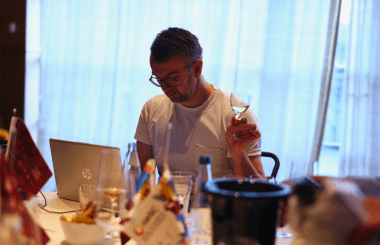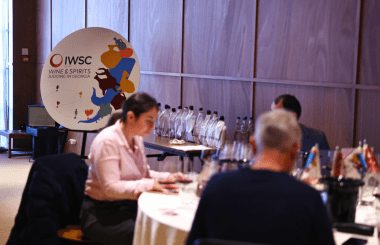East Meets West in Perfect Harmony with Sake and Rice Wine
Rice wine's moment has arrived. At IWSC 2025, sake and rice wine entries achieved an impressive 91% medal rate, with three Gold medals (95 points each) spanning Japanese sake craftsmanship and Chinese huangjiu tradition. The results prove that rice-based fermentation produces some of the world's most sophisticated, food-friendly expressions.
Leading the field were Akashi-Tai Junmai Daiginjo Genshu (Gold, 95 points), Chotokusen Jyumangame Daiginjo Sake (Gold, 95 points), and China's Plumate-Scent Rice Wine (Gold, 95 points) - demonstrating how both traditional Japanese techniques and Chinese huangjiu mastery are earning international recognition.
Two Traditions, One Excellence"In the final category that Asian spirits judged at IWSC, we did huangji, some other rice wines and a little bit of sake. There were a few bottles, and they were good again," notes Marie Cheong-Thong, IWSC Spirits Judging Committee member.
The medal winners revealed fascinating contrasts. Japanese entries showcased sake's technical precision - from the highly polished elegance of Junmai Daiginjo expressions to innovative craft sakes like Akashi-Tai Ginjo Yuzushu (Silver, 90 points) and Shiraume Ginjo Umeshu (Silver, 91 points), which blend traditional brewing with citrus and plum.
Chinese huangjiu entries demonstrated remarkable diversity across sweetness levels, from semi-dry expressions like Yu Meng Zui Xiang Huang Jiu (Silver, 91 points) to the rich complexity of extra-sweet styles. The aged 2012 Rice Wine from Yuan Group (Bronze, 87 points) proved that time adds depth to these already complex fermented wines.
The Standout StoryThe standout story was London Craft Sake's White Koji Sparkling Sake (Silver, 90 points), proving that sake innovation isn't confined to Japan. This demonstrates how traditional techniques are inspiring global creativity, much like craft beer's international evolution.
"There are eight different types of sake, starting from your futsu-shu, your honjozo, two different types of ginjos, two types of daiginjos, and tokubetsu, which just means special," explains Cheong-Thong. "We look at the rice variety, the yeast used, the style of koji, how long it's fermented and at what temperature to create the flavours and textures."
Even Korea contributed with Pungnyeon 1979 Makgeolli (Bronze, 86 points), showcasing rice wine's broader regional interpretations.
Commercial RenaissanceThe category's medal distribution - 14% Gold, 41% Silver, and 36% Bronze - reflects consistent quality that's attracting sommeliers and mixologists worldwide. Sake's lower ABV (12-16%) aligns perfectly with moderation trends, while its umami complexity offers unprecedented food-pairing possibilities.
The innovation extends beyond traditional boundaries. Fruit-infused expressions and sparkling styles are creating new entry points for curious consumers, while aged huangjiu offers complexity that rivals fine sherry or aged spirits.
"Over 10 years of judging, I've seen the quality of Asian spirits go up so much", reflects Cheong-Thong.
The results suggest rice wine and sake are poised for broader international appreciation. With their food-friendly profiles, artisanal production methods and growing innovation, these fermented rice expressions offer exactly what today's sophisticated drinkers seek: authenticity with accessibility.
Explore the full list of Sake & Rice Wine winners below.
| Score | Award | Producer | Entry Name | Producer Country | Type |
|---|---|---|---|---|---|
| 95 | Gold | Akashi Sake Brewery | Akashi-Tai Junmai Daiginjo Genshu | Japan | Junmai Daiginjo |
| 95 | Gold | Kameda Shuzo | Chotokusen Jyumangame Daiginjo Sake | Japan | Daiginjo |
| 95 | Gold | Ikaffe Partner Co. | Plumate-Scent Rice Wine | Taiwan | Sweet / Tian |
| 91 | Silver | Shaoxing Yunji Xinji Wine Co. | Yirujiehuo Handmade Yellow Wine | China | Semi Sweet / Ban Tian |
| 91 | Silver | Shaoxing Yunji Xinji Wine Co. | Yu Meng Zui Xiang Huang Jiu | China | Semi Dry / Ban Gan |
| 91 | Silver | Akashi Sake Brewery | Akashi-Tai Shiraume Ginjo Umeshu | Japan | Craft Sake (Using Secondary Ingredients) |
| 91 | Silver | Yaegaki Sake & Spirits | Mu Junmai Daiginjo Sake | Japan | Junmai Daiginjo |
| 90 | Silver | Dongyang Qinglian Winery | Daqian Craft 20 YO Rice Wine | China | Semi Sweet / Ban Tian |
| 90 | Silver | Shaoxing Yunji Xinji Wine Co. | Yu Ruo Wang You Handmade Rice Wine | China | Extra Sweet / Nong Tian |
| 90 | Silver | KANPAI - London Craft Sake | White Koji Sparkling Sake NV | United Kingdom | Junmai |
| 90 | Silver | Akashi Sake Brewery | Akashi-Tai Ginjo Yuzushu | Japan | Craft Sake (Using Secondary Ingredients) |
| 90 | Silver | Sake ONO | Sake Ono Junmai Daiginjo | USA | Junmai Daiginjo |
| 89 | Bronze | Yaegaki Sake & Spirits | Mu Black Junmai Daiginjyo Sake | Japan | Junmai Daiginjo |
| 89 | Bronze | Miyoshikiku Sake Brewery Co. | Recosake | Japan | Junmai Ginjo |
| 88 | Bronze | GDMZH Pearl Red Spirits & Wines Co. | Pearl Red Hakka Rice Wine | China | Sweet / Tian |
| 88 | Bronze | Yaegaki Sake & Spirits | Ritsu Junmai Sake | Japan | Junmai |
| 87 | Bronze | Yuan Group | 2012 Rice Wine | China | Semi Dry / Ban Gan |
| 86 | Bronze | Yuan Group | 2021 Rice Wine | China | Semi Dry / Ban Gan |
| 86 | Bronze | Da Reun O Reum | Pungnyeon 1979 Makgeolli | South Korea | Rice Wine (Other) |
| 86 | Bronze | Kuaijishan Shaoxing Wine Co. | Master Lanting Huangjiu | China | Semi Dry / Ban Gan |



